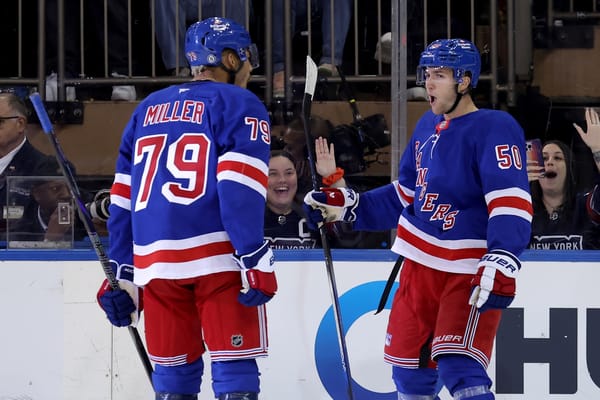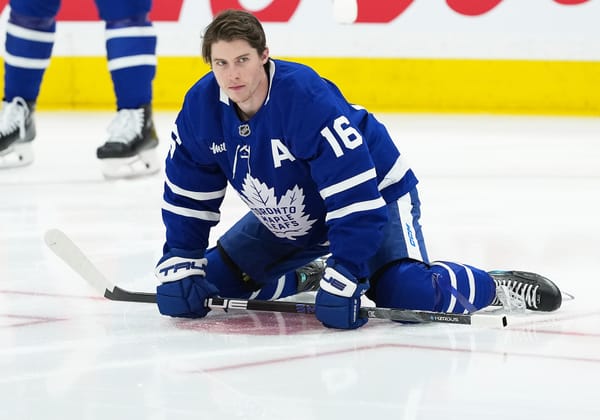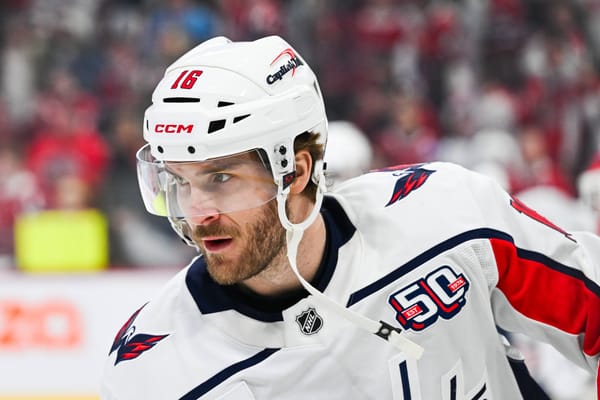Blueshirt Banter 2019 New York Rangers Prospect Rankings: 15-11
15. Tarmo Reunanen, Left Defense
2018 Ranking: 36
Age: 21
Acquired Via: 2016 Draft (Fourth Round)
After three-straight frustrating seasons filled with injuries and a struggle to find consistent playing time, Tarmo Reunanen finally hit his stride during the 2018-2019 season. With a fresh start with Lukko of Liiga (Finland), Reunanen finally carved out a full-time spot in the lineup and was earning 18-20 minutes in the early part of the season. From there, his play improved and his confidence grew and by December, he was a lynchpin for Lukko. He routinely earned 20-plus minutes every night, and at times flirted as high as 27 minutes.
Tarmo Reunanen has 9 points in his last 11 games for Lukko and averages almost 27 minutes per-night during that time. Playing the best hockey of his life in all three zones. Just needed a healthy run. #NYR
— Alex Nunn (@aj_ranger) January 12, 2019
Everything went well for Reunanen. He was producing points and the rest of his game supported the idea that this was not a fluke. He carried the puck with purpose and generated a number of shot attempts while creating offense.
#NYR prospect defenseman Tarmo Reunanen had 2 assists in the first period. This second one was gorgeous. #Liiga #Lukko pic.twitter.com/oVt0dXwyWy
— Jokke Nevalainen (@JokkeNevalainen) March 22, 2019
Our own Alex Nunn got to speak with Reunanen about his successful season, which you can read here. Highly recommended.
Reunanen is the perfect example of why some talented teenagers might just need time to marinate and a legitimate opportunity to build confidence. Reunanen went through a few ugly duckling years, and last summer he was on the fringe of irrelevance. The Rangers showed how good they felt about him after this season when they rewarded him with a contract.
No prospect in the organization improved his stock more than Reunanen has over the last 12 months. Reunanen could play in Hartford next year, or the Rangers could opt to loan him back to Finland for one more year. It will depend on the organizational depth chart, among other things. He still has a fair amount of development left if he is to make the NHL, but Reunanen has re-established himself as a potential two-way, puck-moving defenseman.
14. Adam Huska, Goaltender
2018 Ranking: 13
Age: 22
Acquired Via: 2015 Draft (Seventh Round)
Truthfully, Huska’s 2018-2019 season did not go well. The Slovakian goaltender began the campaign rather well and hovered around the .920 save percentage mark through the first handful of games with UConn. Around Thanksgiving, though, his game completely fell apart, as he was giving up a bountiful number of goals, with many of them on shots he should have been stopping. That was atypical for Huska, who usually has great mechanics and has no problem with those low-percentage shots.
By February, his save percentage was sub-.900, and for the first time in his three-year college career he lost UConn’s starting job to Nashville draft pick Tomas Vomacka. We could partly blame UConn’s weak roster for Huska’s struggles, but he performed well on equally bad teams his previous two seasons. Furthermore, Vomacka himself did very well behind the same team, posting a .922 save percentage.
Huska completed the season with a .896 save percentage in 21 games, a far cry from the staunch netminder who consistently dragged UConn to victories — or at least kept games competitive — during his freshman and sophomore campaigns.
Huska opted to leave UConn and sign with the Rangers at the end of the season. He played nine games behind a skeleton Wolf Pack roster, but after a rough first few games, Huska found his form in Hartford’s last few games and finished the season strong.
Despite Huska’s unsuccessful season, I’m inclined to give him the benefit of the doubt. By virtue of signing him, the Rangers seem to feel the same. Huska was a stalwart the previous three seasons, thriving for one season in USHL, two seasons in the NCAA, and some strong World Juniors performances were mixed in as well. Huska will battle with AHL signing Tom McCollum for the backup spot in Hartford, and I would think the job is his to lose.
13. Libor Hajek, Left Defense
2018 Ranking: 11
Age: 21
Acquired Via: Trade (2018)
I was notably lower on Hajek than most last summer, but I never would have imagined that his transition to pro hockey would be so rough. The Rangers expected Hajek to compete for a spot on the NHL roster out of camp. Not only did that not happen, but he immediately struggled in Hartford.
His offensive game was non-existent. As I documented last season, the idea that shutdown defensemen don’t need to produce at lower levels is nonsense. Zero goals and five assists in 58 games not only speaks to his lack of production, but also to other aspects of the game that will incidentally lead to offense. He looked overwhelmed often whenever he handled the puck. He gave up possession frequently, which not only stunted Hartford’s offense, but left them vulnerable in the defensive end.
That is just a small sample of Hajek’s struggles with the puck. In these clips, Hajek gives the puck away despite having a whole lot of time and space. He doesn’t need to be a big point producer, but he has to at least show some ability to push play forward for his team. He has to be able to make basic outlet passes.
He was better defensively than he was offensively, but even that part of his game was inconsistent. He had some moments where his shutdown abilities really showed, and others where he looked out of place in the AHL.
It’s tempting to write this all off as a consequence of the toxicity in Hartford. I’m not so sure. That’s certainly part of the reason for his struggles, but not all. That argument does not explain why he couldn’t make basic passes from the defensive zone, or why he was outperformed by Brandon Crawley, Ryan Lindgren, and Sean Day, all of whom had to deal with the same exact circumstances. That’s a point I think a lot of people haven’t fully grasped. Even if we apply a generous grading curve to Hartford players, Hajek still finished at the bottom of the class.
Bizarrely, Hajek received a call-up from the Rangers and actually played far better than he did the whole season in the AHL. He defended well and made respectable plays with the puck. The Rangers out-attempted the opposition 69-to-56 with Hajek on the ice at 5v5, which is stupendous given the team’s general propensity for getting piled on. And he even scored his first NHL goal.
First NHL goal for Libor Hajek! #NYR pic.twitter.com/KJmbKYhxNp
— Shayna (@hayyyshayyy) March 10, 2019
Hajek is a player who looked absolutely putrid in 58 games in the AHL, and absolutely wonderful in five NHL games. Do we put more stock in the large sample at a lower level, or the tiny sample at the highest level? It’s tough to parse. What a shame it is that Hajek separated his shoulder, which limited our look at him in the NHL.
For now, I’m going to meet him in the middle. Hajek is a much better player than he showed himself to be in Hartford, but there should be real concern about how his lack of offensive prowess might limit him going forward. He is a strong contender to earn a spot on the roster in training camp, though it shouldn’t be assumed. I’m as skeptical as ever that Hajek will ever live up to the Rangers’ initial expectations, but he’s still got upside as a depth shutdown defenseman.
12. Zac Jones, Left Defense
2018 Ranking: N/A
Age: 18
Acquired Via: 2019 Draft (Third Round)
I had limited knowledge of Jones when the Rangers drafted him in the third round in June and took an agnostic position on the selection. In the last few weeks that I’ve watched him play, I’ve grown to very much like this selection.
Jones is a puck-moving defenseman who relies on his feet and his brain to make plays. His straight-line speed is nondescript at best, and I think he would do well to add some power to his stride. His stride is a bit bow-legged, though he possesses extraordinary agility. Jones’ crossovers, pivots, and turns are smooth and efficient. He changes directions like it’s nothing. He looks like an NFL running back with the way he shakes defenders and carries the puck into open lanes.
Jones has incredible puck poise and vision. He’s an intelligent player who knows how to wait for lanes to open up, whether for passes or shots. While his shot doesn’t have much intensity behind it, he has a controlled wrister that he does well to get through traffic. What’s more, he’s very capable of finding his teammates in the slot for deflections.
While having a big slapper never hurts, the game is changing to favor defensemen like Jones. Getting shots through, which create deflections, screens, and rebound opportunities is the priority.
Watching this next play unfold was a real “wow!” moment for me:
That is Jones reading the play and thinking multiple steps ahead, purposely passing the puck off the boards to his pinching defensive partner at the far post. A play like this isn’t an accident. It really shows off his vision.
And finally, a play like this captures a bit of everything in Jones’ game.
There’s nothing jaw-dropping there, but it shows a lot of the little ways in which Jones impacts the game. Retrieve the puck, use your agility to get out of trouble, and then have the poise to wait for a passing lane to develop. Jones calmly turns a forechecking opportunity for the opposition into a shot on goal for his own team in a matter of seconds.
At 5’10 and 176 pounds, Jones is undersized. However, he’s not afraid to engage physically. He’ll battle for positioning in front of the net or in the corners during puck battles. He needs to get stronger, and physicality will never be his calling, but the requisite willingness to participate is there.
There aren’t really major holes in Jones game. Instead, his NHL future will depend on getting a little bit better at a lot of things. He needs to improve his skating stride and add more explosiveness. He needs to get stronger and work a bit more on disrupting play on the defensive side. Add a little velocity to his shots, and so on.
My ranking of Reunanen and Hajek could be interpreted as a knock on them, but I don’t view it as such. I’m very impressed with Jones and I think the Rangers got a really good prospect in the third round. He’ll play for Umass Amherst next season, and with some seasoning he has a real shot at becoming a two-way, puck-moving defenseman on an NHL second pairing.
11. Karl Henriksson, Center
2018 Ranking: N/A
Age: 18
Acquired Via: 2019 Draft (Second Round)
The Rangers badly needed to add a center to their prospect mix, and they did so when they took Karl Henriksson 58th overall this past June.
Henriksson is a creative center who thrives when the puck is on his stick and there is an opportunity to initiate offense. He centered Sweden’s top line at both the Hlinka/Gretzky Cup as well as the U18 World Championship, and the play often started with him. With short, rapid strides, he loves to carry the puck up the ice and set his team up for controlled offensive zone possessions.
The one ability that clearly defines Henriksson’s value is his knack for passing the puck inside the offensive zone. In particular, he is skilled at finding passing lanes while on the move. Plenty of players can make a good pass while at a standstill, but hockey is a fast, dynamic sport. Henriksson’s ability to make plays while he’s moving his feet is an extremely encouraging sign that he can produce offense at higher levels.
At 5’9, he uses a short stick, but he makes the best of it. With dexterous hands, he changes his hand positioning and will quickly drag or push the puck to create different passing angles. With that, he finds ways to make otherwise inconvenient passes; sometimes around defenders.
On a Swedish power play that had a lot of talent, Henriksson played point guard. Like many good playmaking centers, he sets up on the left-side half-wall and dictates the offense from there.
Here are some examples of Henriksson passing the puck (#20 on Sweden).
Henriksson will score his share of goals, but there’s no mistaking that his playmaking ability is his meal ticket.
In regards to his size (again, 5’9), I’m not overly concerned. Sure, that is diminutive for a . center. However, he finds ways around it. Henriksson has a low center of gravity keeps his legs churning. As such, he is strong on his skates. Here is one clip which does a decent job of showing his ability to fight through sticks and limbs.
However, this is also a display of one of his worst tendencies; sometimes he tries to force a play even when it’s ill-advised. In this case, he manages to get away with it, but he was close to giving the puck away in his own team’s slot. Henriksson needs time to learn how to pick his spots.
Another major issue with Henriksson is inconsistent defensive effort. There are times when he is engaged and does his job in the defensive end. In fact, he had a role on Sweden’s penalty kill. However, far too often he is very timid. There were a few times at the Hlinka/Gretzky Cup where he seemed disengaged, watching the play unfold instead of trying to get involved and pressure the puck. He also hesitates at times when there’s a physical battle to be had in the defensive slot.
Finally, there has to be a worry that his numbers for Frolunda’s J20 team (49 points in 45 games) were influenced by linemate Lucas Raymond. Raymond is a prodigy who played 10 games in the Swedish Hockey League as a 16-year-old and who is, in my mind, the clear-cut #2 overall pick for the 2020 Draft.
Raymond drives play, but it does not appear that Henriksson was a parasite. Still, it has to be a mild concern.
NYR picked Frolunda forward Karl Henriksson in the 2nd round yesterday.
— Evan Oppenheimer (@OppenheimerEvan) June 23, 2019
I wasn't sure how much of Henriksson's 49 points in 45 SuperElit games had to do with him playing with 2020-eligible stud Lucas Raymond, and it looks like Henriksson scored a lot without Raymond's help. pic.twitter.com/fugem0JTRb
Henriksson is very raw and it’s going to probably be quite a wait before he’s really on the NHL radar. Still, he has a lot of upside as a top-six, playmaking center. Credit the Rangers for recognizing a need and taking a gamble on talent.
Christoffer Hedlund wrote a more in-depth scouting report on Henriksson over at EP Rinkside. I recommend it if you have the time.




